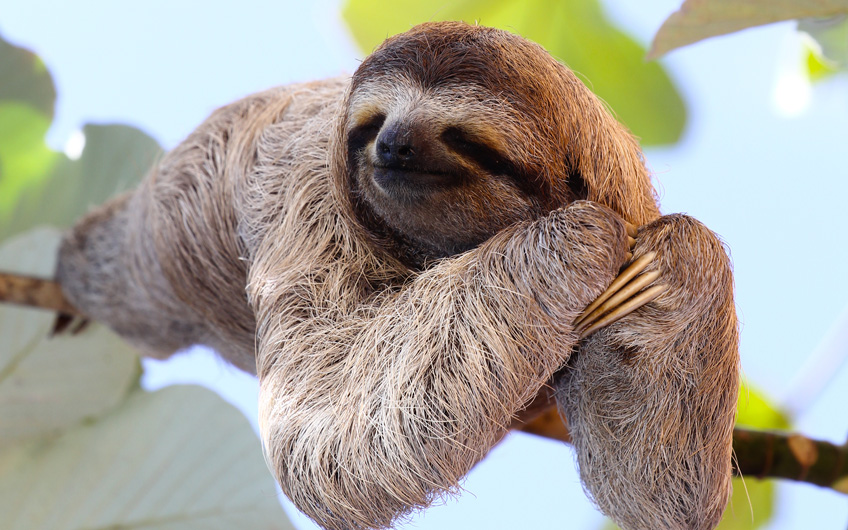
Sloths in Costa Rica are an even more growing target for visitors looking to get close to them. Their smiling faces and funny laziness are two of the reasons why people love them and look for them during their holidays in the country. While lodging at your hotel or all inclusive resort, keep always looking outside because you probably will spot them.
First of all, you may know that Costa Rica is an excellent place to spot sloths in their natural ambiance, as the country has the 5% of the world’s biodiversity and there are a lot of places where you can be so close of the natural sloth habitat, and this results very attractive for both, locals and foreigners.
This travel guide created by the Travel Excellence team will explore all things related to sloths in Costa Rica! Basically answering all the questions related to finding these charming mammals, which are also recognized as a national animal in Costa Rica, symbolizing the country’s commitment to wildlife conservation. Learn where to see sloths in Costa Rica.
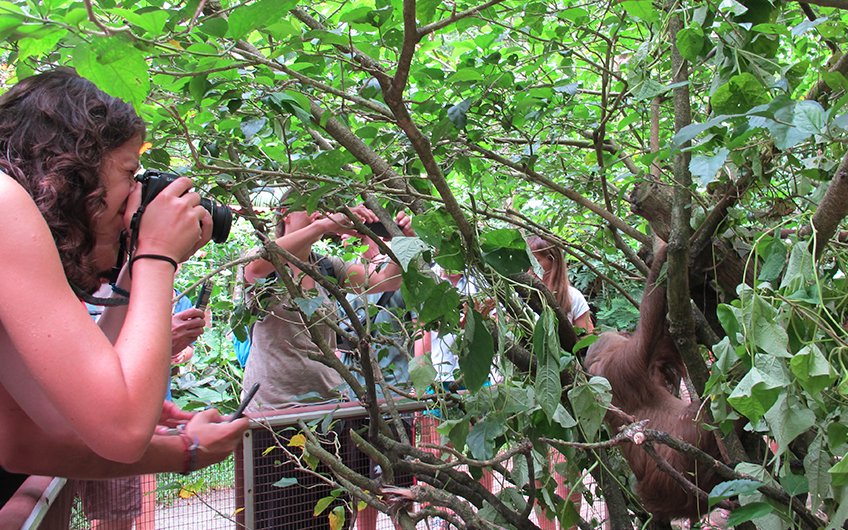
In Costa Rica, there are two types of sloths: the Hoffman’s two-toed sloth and the brown-throated three-toed sloth. These charming creatures can be found in several areas, prompting people to search online for “Where to see sloths in Guanacaste, Costa Rica?”, “Best places to see sloths,” or “How to find a sloth in Costa Rica?” The answer is, there are two ways for spotting sloths in the country:
Monteverde Cloud Forest is a place that boasts 2.5% of the world’s biodiversity… just imagine it! Within the lush vegetation you will surely find the opportunity of seeing these nice creatures.
The Corcovado National Park which is located in the southwest region of Costa Rica, specifically in the Osa Peninsula which is a biologically rich part of the country. The area contains 13 major ecosystems, so you definitely will have the chance to spot more than one of them during your vacation in Costa Rica.
La Selva Biological Station is located in Sarapiquí and it is a protected zone operated by the Organization for Tropical Studies (OTS) and here it is possible to find sloths in their natural ambiance.
Just be aware of the following question, “Where Can I Hold a Sloth in Costa Rica?”, after answering we are going to give you all the information about the best places to see sloths in Costa Rica, but also take in account that few do not offer guided tours but some will do. Keep reading to get all the information you need.
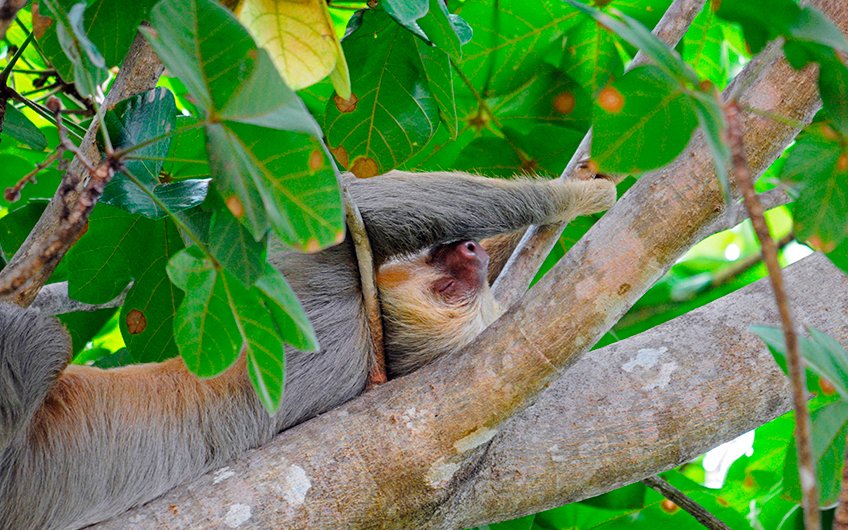
While some countries may offer sloth-holding experiences, Costa Rica prioritizes ethical and responsible wildlife tourism. Holding, touching, or taking selfies with sloths may seem appealing, but it has serious negative consequences for these animals. This mammal is Costa Rica’s national animal and they have laws that protect their environment and well-being.
At Travel Excellence, we understand the desire to see sloths up close, but we strongly discourage the practice of holding them. Costa Rica is a leader in wildlife conservation, with 28% of its land protected in national parks, reserves, and wildlife refuges. We must respect sloths as wild animals and prioritize their well-being.
The Sloth Institute in Manuel Antonio provides these excellent guidelines on “7 Ways to Be a Responsible Sloth Tourist”:
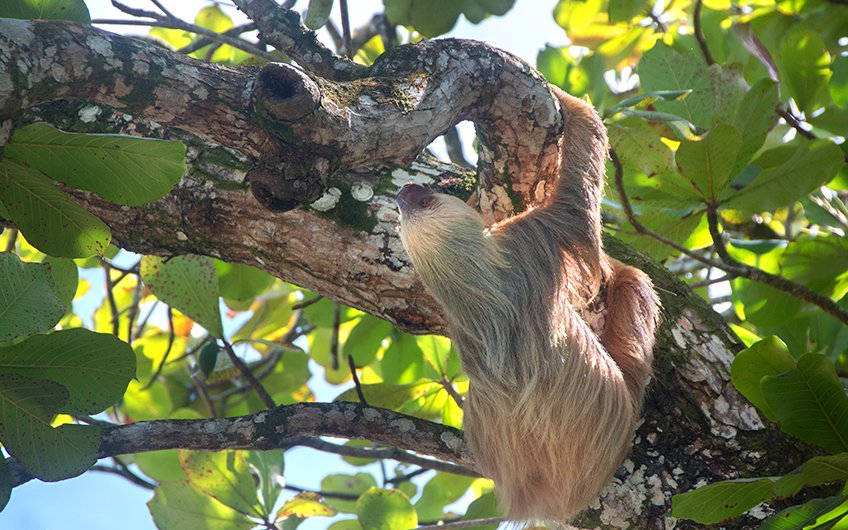
Sloth sanctuaries in Costa Rica are the best place to see sloths in Costa Rica, they play a crucial role in protecting these vulnerable animals. They offer a lifeline to sloths that have been injured, orphaned, or displaced due to habitat loss. Through specialized care and rehabilitation, these sanctuaries help sloths recover and thrive, with the hope of eventually returning them to their natural homes in the rainforest.
Costa Rica boasts numerous sloth sanctuaries, each offering unique experiences and located near major international airports (SJO in San Jose or LIR in Liberia). Whether you’re exploring the cloud forests of Monteverde, the beaches of Cahuita and Puerto Viejo, or the adventurous landscapes of La Fortuna and near the town of Liberia, Guanacaste, you’ll discover dedicated centers for sloth rescue and rehabilitation. This comprehensive guide details each sanctuary’s offerings to help you plan your ideal visit.
To navigate quick, click each Sanctuary:
Location: Cahuita, Route 36, 30 km South of Limón Province, Costa Rica 7302
Meet resident sloths at The Sloth Sanctuary in their safe haven. Learn about their rescue stories and why sanctuaries are crucial for their survival.
Departure Times: 8 AM, 9 AM, 10 AM, 11 AM, 12 PM, 1 PM, 2 PM
Get exclusive behind-the-scenes access to the NICU/Nursery, where you’ll see baby sloths and hear their unique rescue journeys.
Departure Times: 9 AM (morning tour), 1 PM (afternoon tour)
Location: Monteverde, Puntarenas, Costa Rica
Explore a meticulously designed exhibit at Selvatura Sloth Habitat that mirrors the natural habitat of sloths. Observe 20 resident sloths, both two-toed and three-toed, as they roam freely among the trees. Learn about sloth behavior, conservation efforts, and the challenges these gentle creatures face.
Tours depart daily at 8:30 AM, 11:00 AM, 1:00 PM, and 2:30 PM.
Selvatura’s Sloth Habitat offers a peaceful and immersive experience, allowing you to witness these fascinating creatures at a comfortable distance. Learn about the different types of sloths native to Costa Rica (two-toed and three-toed) and their unique adaptations.
Discover the challenges sloths face in the wild, such as habitat loss and poaching, and how the sanctuary is working to protect them. Witness the sloths’ relaxed pace of life as they roam freely through a habitat designed to mimic their natural environment.
Gain a deeper appreciation for these incredible creatures and the importance of conservation efforts.
Location: Jabillos, Florencia, San Carlos, Alajuela, Costa Rica, 21002
An educational tour where you can observe both two-toed and three-toed sloths up close in a safe, non-intrusive environment. Learn about the rescue and rehabilitation efforts for these amazing creatures and the importance of sloth conservation.
Tour Times: Monday to Saturday: 8:30 AM, 10:30 AM, and 1:30 PM
For more Sloth Tours in La Fortuna, click here.
Founded in 2002, Proyecto Asis is a non-profit organization dedicated to wildlife protection, environmental conservation, and community education.
Near the stunning Arenal Volcano National Park, Proyecto Asis offers a unique opportunity to learn about sloths in their rescue center. The sanctuary is dedicated to rescuing and rehabilitating injured and orphaned sloths, with the ultimate goal of releasing them back into the wild.
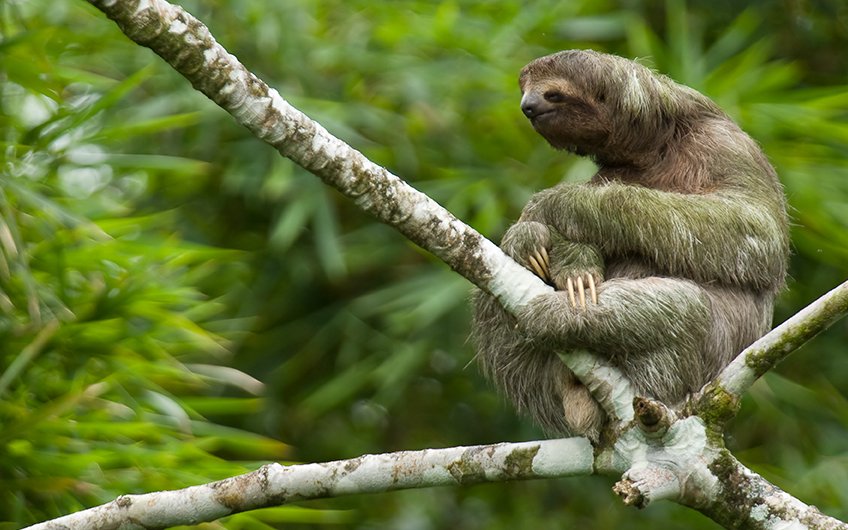
Location: C. Juntas, Turrúcares, Alajuela Province, Costa Rica
Witness the dedication and care provided by Costa Rica Animal Rescue Center to rescued animals, including sloths, monkeys, and birds. Learn their stories of rescue and rehabilitation, understand the center’s vital role in conservation, and experience firsthand the beauty of Costa Rican wildlife.
Tour Times: Daily tours at 9 AM, 10 AM, 11 AM, 1 PM, and 2 PM. Closed from 12 PM to 1 PM for lunch.
The Costa Rica Animal Rescue Center provides a unique opportunity to observe and learn about rescued animals in a natural, supportive environment. During the tour, you’ll:
Location: Matapalo, Guanacaste, Costa Rica
Explore the Animal Sanctuary at Diamante Eco Adventure Park, home to a variety of rescued Costa Rican wildlife, including sloths, monkeys, jaguars, toucans, and more. Witness their expertly designed habitats and learn about their unique stories and conservation needs from the knowledgeable bilingual staff.
Tour Times:
Open daily: From 8:30 AM to 4:30 PM.
Sloth feedings occur: At 9:30 AM, 12:30 PM, and 3:30 PM, offering an excellent chance for observation.
Diamante Eco Adventure Park offers a unique opportunity to observe and learn about rescued animals in a stunning natural setting. Highlights of your visit include:
Diamante Eco Adventure Park prioritizes animal welfare and follows strict guidelines to ensure the animals’ well-being. Visitors are asked to respect the sanctuary rules, which include:
Location: Cruce de Manolo’s, Ruta 3, towards Barrio San José, Alajuela Province, Costa Rica
Explore the sanctuary’s 2.5 km of trails through lush botanical gardens, and observe over 120 species of rescued wildlife in their natural habitats.
Enhance your experience with a knowledgeable guide who will share the stories of the animals, explain the center’s conservation efforts, and offer deeper insights into Costa Rica’s biodiversity.
Tour Times: Open daily from 9:00 AM to 5:00 PM, including holidays.
Rescate Wildlife Rescue Center is a haven for animals that have been injured, orphaned, or rescued from the illegal pet trade. During your visit, you’ll:
To ensure the safety and well-being of the animals, please follow these rules:
Location: Alto de las Palomas, Santa Ana, San José Province, 10094 (Just 20 minutes from downtown San José!)
Embark on a guided tour that immerses you in the stories of over 75 Costa Rican animal species. Discover why these fascinating creatures, including sloths, have become educational ambassadors due to their inability to return to the wild.
The Refugio Animal de Costa Rica is more than just a tourist attraction. It’s a haven where animals are given a second chance. Your visit not only provides a memorable experience but also fuels the ongoing work to save and protect Costa Rica’s precious wildlife.
If you’re seeking an authentic wildlife encounter near San José, the Refugio Animal de Costa Rica offers a unique and rewarding opportunity to connect with nature and support a vital conservation mission.
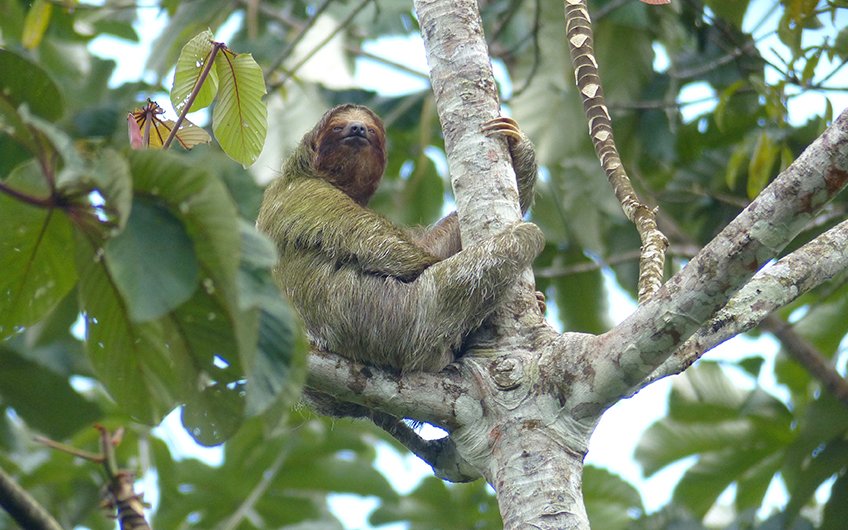
Dreaming of seeing sloths in their natural habitat? Costa Rica is your ultimate destination for unforgettable sloth-watching tours. Another option instead of visiting sanctuaries and refugees, embark on guided adventures into the wild to observe these gentle creatures napping, moving through the trees, and interacting with their environment.
There are a lot more places where you can find sloths. Just to give you an idea, in the installations of the University of Costa Rica (UCR) many students and teachers have been able to see and be in close contact with these animals. And the UCR is located located in San Pedro de Montes de Oca, San Jose, in the middle of the capital city!
Get ready to discover the secrets of these slow-moving mammals with experienced guides who know exactly where to find them:
This 1.5-hour guided rainforest hike covers 2 miles of easy, mostly shaded trails to spot sloths in their natural habitat. Expect to see 4-6 sloths on average, along with various birds, frogs, insects, and other wildlife. Bring bug spray for the occasional open areas.
On the Bogarin Trail’s guided rainforest tour, you’ll spend approximately two hours exploring the lush La Fortuna area with an experienced guide. They’ll help you spot wildlife like sloths, toucans, and basilisks using telescopes, and share fascinating facts about the local flora and fauna.
The easy hike concludes with refreshing pineapple and a chance to relax amidst the natural sounds of the rainforest.
This guided sloth watching tour offers multiple daily departures between 8:00 AM and 3:00 PM. You’ll explore a lush gallery forest filled with giant trees and diverse wildlife, with a focus on spotting two-toed and three-toed sloths.
The experienced Rodríguez family guides possess the skills needed to locate these well-camouflaged creatures.
Travel Excellence has explored the enchanting world of sloths in Costa Rica, highlighting the best places and practices for observing these gentle creatures. The emphasis on ethical wildlife interactions and conservation is a crucial part of this guide, underscoring the importance of respecting these animals by avoiding direct contact and supporting sanctuaries and eco-friendly businesses.
By adhering to responsible tourism practices, visitors can ensure their encounters with Costa Rica’s beloved sloths are both memorable and beneficial to the ongoing efforts to protect these unique animals and their environment.
We are active members of the most important tourist associations, both national and international.
To navigate this site use a different one than Microsoft Explorer.